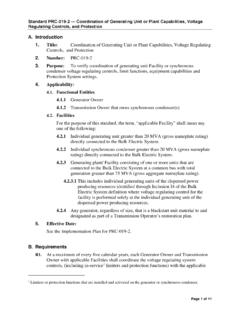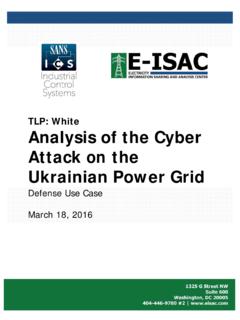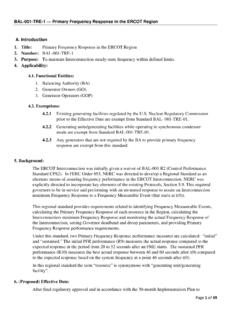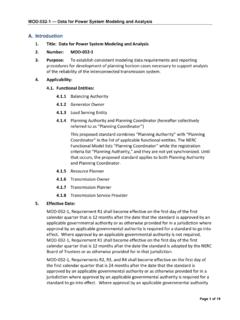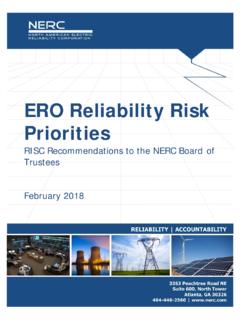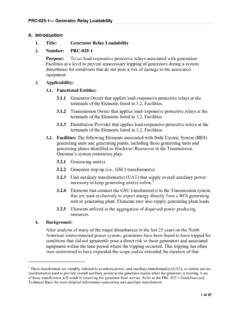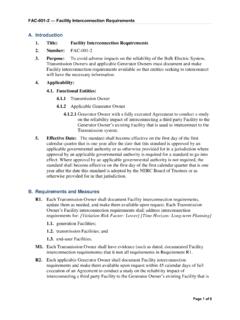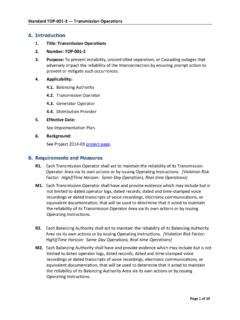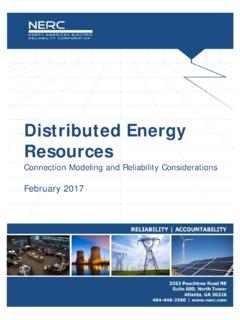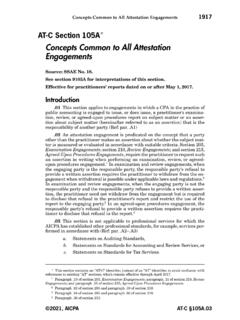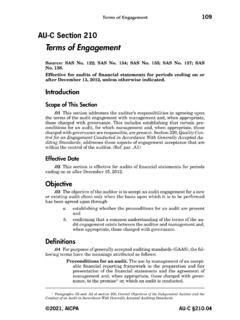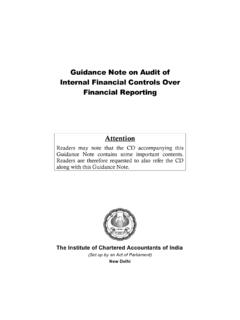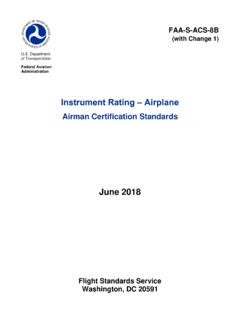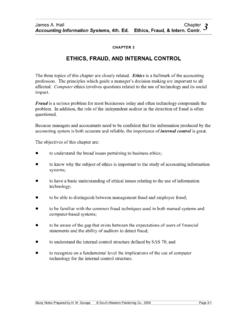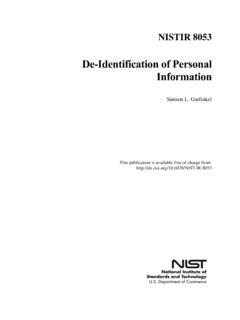Transcription of Guide for Internal Controls V2 - NERC
1 NERC | Report Title | Report Date I ERO Enterprise Guide for Internal Controls Version 2 September 2017 NERC | ERO Enterprise Guide for Internal Controls Version 2 | July 2017 ii Table of Contents Preface .. iii Introduction .. iv Revision History .. v Internal Controls and Compliance Monitoring ..1 Understanding Internal Controls during CMEP Activities ..2 Approach for Testing Internal Controls ..3 Major Inputs ..3 Evaluation of Design and Implementation ..3 Internal control Design ..3 Using the Work of Others ..4 Internal control Implementation ..4 Finalize Conclusions ..5 Outcome ..5 Reviews and Retests of Internal Controls .
2 6 Internal Controls Evaluation ..6 ICE Objective ..6 ICE Timing and Selection of Internal Controls ..6 Results Documentation ..7 Sharing Results ..7 Documentation Retention ..7 References ..8 Appendix A: Considerations for Understanding control Design ..9 Using Key Controls to Prioritize Testing ..9 Appendix B: Definitions .. 10 NERC | ERO Enterprise Guide for Internal Controls Version 2 | July 2017 iii Preface The North American Electric Reliability Corporation (NERC) is a not-for-profit international regulatory authority whose mission is to assure the reliability and security of the bulk power system (BPS) in North America. NERC develops and enforces Reliability Standards; annually assesses seasonal and long-term reliability; monitors the BPS through system awareness; and educates, trains, and certifies industry personnel. NERC s area of responsibility spans the continental United States, Canada, and the northern portion of Baja California, Mexico.
3 NERC is the Electric Reliability Organization (ERO) for North America, subject to oversight by the Federal Energy Regulatory Commission (FERC) and governmental authorities in Canada. NERC s jurisdiction includes users, owners, and operators of the BPS, which serves more than 334 million people. The North American BPS is divided into eight Regional Entity (RE) boundaries as shown in the map and corresponding table below. The highlighted areas denote overlap as some load-serving entities participate in one Region while associated transmission owners/operators participate in another. FRCC Florida Reliability Coordinating Council MRO Midwest Reliability Organization NPCC Northeast Power Coordinating Council RF ReliabilityFirst SERC SERC Reliability Corporation SPP RE Southwest Power Pool Regional Entity Texas RE Texas Reliability Entity WECC Western Electricity Coordinating Council NERC | ERO Enterprise Guide for Internal Controls Version 2 | July 2017 iv Introduction Effective Internal Controls support the reliability and security of the bulk power system (BPS) by identifying, assessing, and correcting issues; and their use can demonstrate reasonable assurance of compliance with NERC Reliability Standards.
4 This ERO Enterprise Guide for Internal Controls describes the Electric Reliability Organization (ERO) Enterprise approach for understanding and assessing Internal Controls as part of the overall Risk-Based Compliance Oversight Framework (Framework).1 This Guide includes the ERO Enterprise approach for assessing Internal Controls during compliance monitoring activities. This Guide also assists Compliance Enforcement Authorities (CEAs) in identifying and considering existing registered entity risk mitigation practices (commonly referred to as Internal Controls ) in the development of the CEA s Compliance Oversight Plan (COP) for that particular registered entity. The process for evaluating Internal Controls described herein applies to any type of registered entity regardless of size or function. As discussed, the Internal Controls evaluated relate to the inherent risk posed by a particular registered entity and any associated NERC Reliability Standards.
5 Therefore, the extent of an evaluation and the application of the evaluation criteria will vary in accordance with the level of inherent risk posed by the registered entity. Even effectively designed and implemented Internal Controls cannot provide absolute assurance of compliance with NERC Reliability Standards. The ERO Enterprise Guide for Internal Controls describes the approach CEAs use to assess the effectiveness of design and implementation of a registered entity s Internal Controls . It also accounts for the need to scale testing of Internal Controls to take into consideration the wide range of entity size and risk characteristics. The CEA develops a registered entity s COP following the process described in the ERO Enterprise Guide for Compliance Monitoring,2 which considers results of Internal control testing and other Internal control information identified during Compliance Monitoring and Enforcement Program (CMEP) activities.
6 The COP is dynamic, and CEAs may make modifications based on changes to the registered entity inherent risk assessment (IRA), Internal Controls , and performance considerations. 1 Refer to the ERO Enterprise Overview of Risk-Based CMEP for additional information on the Risk-Based Compliance Oversight Framework. 2 ERO Enterprise Guide for Compliance Monitoring NERC | ERO Enterprise Guide for Internal Controls Version 2 | July 2017 v Revision History Date Version Number Comments December 2016 V1 Renamed the ICE Guide to the ERO Enterprise Guide for Internal Controls Incorporated approach for ERO Enterprise review of Internal Controls during CMEP activities Revised and streamlined testing approach to focus on testing Internal control design and implementation effectiveness Included references to the ERO Enterprise Guide for Compliance Monitoring and content for COP development Updated appendices Appendix A contains revised definitions Appendix B contains additional details around key Controls September 2017 V2 Added series of principles to Section - Internal Controls and Compliance Monitoring Reordered Section pertaining to the potential role of ICE to facilitate a general discussion about the value of
7 Evaluating Internal Controls before addressing Internal Controls Evaluations Clarified process for sharing results in Section NERC | ERO Enterprise Guide for Internal Controls Version 2 | July 2017 1 Internal Controls and Compliance Monitoring The ERO Enterprise follows professional auditing standards ( , Generally Accepted Government Audit Standards (GAGAS3)) when conducting compliance audits and other CMEP Pursuant to such auditing standards, CEA staff will obtain an understanding of Internal Controls through inquiries, observations, inspection of documents and records, review of other CEA staff reports, and direct tests. The nature and extent of procedures CEA staff perform to obtain an understanding of Internal Controls may vary among compliance monitoring activities based on compliance monitoring objectives, inherent risk, known or potential Internal control deficiencies, and the CEA staff s knowledge about Internal Controls gained in prior compliance monitoring activities.
8 A registered entity cannot be found noncompliant based on the Internal control design or implementation unless there is a noncompliance with a requirement of the NERC Reliability Standards. A sound business approach to incorporating effectively designed and implemented Internal control improves operational and compliance performance. Through evaluations, the CEA may take into account good governance practices of registered entities that effectively manage risk to BPS reliability. In addition, the lessons learned from evaluating Internal Controls may encourage the adoption of such practices throughout the ERO Enterprise and industry. To fulfill the ERO Enterprise obligation to assure a highly reliable and secure BPS, the approach and processes for evaluating Internal Controls align with the following principles: Demonstrate reasonable assurance of a registered entity s ability to mitigate reliability risk Inform the risk-based approach for developing registered entity oversight and monitoring Focus on repeatability and sustainability to ensure reliability and security rather than administration to assemble and archive evidence Effective Controls provide value and help registered entities self-identify and mitigate reliability risks and compliance issues, which could lead to the ability to self-log and correct lower-risk issues as Compliance Exceptions rather than navigating through the full enforcement process; improve their reliability and security.
9 Inform the CEA s development of the registered entity s Compliance Oversight Plan (COP); and reduce the burden for audit preparation with a continuous monitoring process rather than a periodic event associated with the registered entity s preparation for compliance monitoring activity. As described in the ERO Enterprise Guide for Compliance Monitoring5, t he ERO Enterprise recognizes that Internal Controls cannot provide absolute assurance of compliance with Reliability Standards. CEAs may modify the nature, timing, or extent of compliance monitoring activities based on their understanding and evaluations of Internal Controls . When developing or updating a registered entity s COP, Internal Controls may be used by the CEA to select appropriate compliance monitoring tools under the CMEP. 3 GAGAS 4 NERC ROP, Section 1207 5 ERO Enterprise Guide for Compliance Monitoring Internal Controls and Compliance Monitoring NERC | ERO Enterprise Guide for Internal Controls Version 2 | July 2017 2 Understanding Internal Controls during CMEP Activities As part of the CMEP process, CEA staff will obtain an understanding of Internal Controls during CMEP activities as well as during other registered entity interactions.
10 The CEA s understanding of Internal Controls during CMEP activities, like a compliance audit, enable the CEA to make better-informed decisions around compliance and the registered entity s ability to sustain compliance and build reliability excellence. Additionally, a CEA s review of Internal Controls during CMEP activities can inform future monitoring and the COP. After reviewing Internal Controls , the CEA should make decisions around the effectiveness of the design and implementation that may change the nature, extent, and timing of compliance testing during fieldwork or future fieldwork ( , audit fieldwork during a compliance audit); identify industry best practices, areas of concern, or recommendations; and refine the registered entity s COP and future compliance monitoring. CEA staff should document decisions around the effectiveness of the Controls . A registered entity s COP should take into consideration Internal control information made available through CMEP activities like Internal Controls evaluations (ICEs), audits, spot checks, self-certifications, or mitigating activities.
